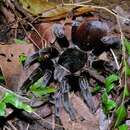Brachypelma vagans (Red-rump Tarantula)
provided by EOL authors
Brachypelma vagans (Red Rump tarantula) is more commonly known as the Mexican Red Rump Tarantula. Their name is derived from the reddish coloring on the back of the abdomen and legs (Edwards and Hibbard 1999). Tarantulas are often thought to have a poisonous bite; however, B. vagans defends itself through bristle-like hairs found on their abdomen and legs which when touched can be extremely painful (Edwards and Hibbard 1999). B. vagans is generally found around the region of Central America, specifically Mexico and Costa Rica. (Locht et al. 1999). This type of tarantula species is frequently seen as a household pet, and have come close to endangerment due to the pet trade (Locht et al. 1999). Their body size can range from 5 to 7 cm, with the females being generally larger than the males (Moore 1994). They feed on smaller vertebrates and arthropods. These are burrowing animals, which spend most of the day in burrowed holes underground, and being nocturnal, they come out to hunt at night (Machkour et al. 2005). They are said to live up to 25 years in the wild, and even longer when kept domestically (Edwards and Hibbard 1999). Females do not reach sexual maturity until they are 9 years old in the wild, but once sexually mature, they typically lay anywhere up to 300 eggs at one time, and the newborn spiders remain close to their mother for multiple weeks after the eggs have hatched (Machkour et al. 2005). These spiders typically stay in colonies of sorts (Moore 1994).

